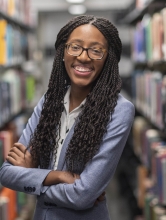Traditional definitions and assessments of creativity often neglect to identify the complexity surrounding Black students’ brilliance, leading to lack of access and funding. Further, even when recognized, Black students are often funneled into programs that do not facilitate positive development of their racial-ethnic identity.
In their article, Black Brilliance and Creative Problem Solving in Fugitive Spaces: Advancing the BlackCreate Framework Through a Systematic Review, Dr. Lauren Mims, assistant professor of applied psychology, and colleagues illustrate how effective Black creative educational experiences (BCEEs) create fugitive spaces for creative expression and education. They conducted a systematic review of 155 publications which yielded the development of the BlackCreate Framework. The framework promotes three overarching principles:
- effective BCEEs create fugitive spaces for creative expression and education;
- BCEEs not only teach specific creative processes, but they teach them as methods for adaptive coping and thriving; and
- with repeated exposure, these adaptive coping mechanisms support positive identity development for Black students.
At its core, this review identified the need to recognize and address fundamental oppression through the intentional development of BCEEs. When systemic oppression was not addressed, it persisted, and when authors did not recognize systemic oppression, they also lost sight of the axiom of brilliance and shifted the blame to the students. Whereas BCEEs occupying powerful fugitive spaces deliberately acknowledged and provided a haven from the broader societal risks.
The authors purport that without recognizing societal risks and cultural assets, Black students will continue to censor themselves in traditional educational settings. Creating opportunities for BCEEs requires reframing creativity to account for the complexity of both the systemic oppression and the community’s support. Therefore, their primary recommendation is to consistently fund, support, and research fugitive spaces for Black students.
The publication can be cited as follows:
Mims, L. C., Rubenstein, L. D., & Thomas, J. (2022). Black brilliance and creative problem solving in fugitive spaces: Advancing the BlackCreate framework through a systematic review. Review of Research in Education, 46(1), 134-165.




